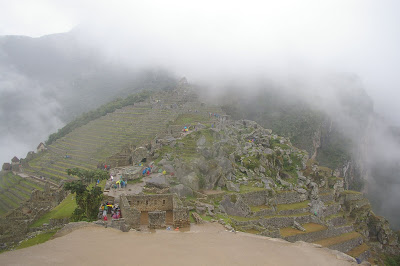After Barcelona, I had a day in Madrid, where (with the constant travel starting to get to me) I decided to eschew any sightseeing, historical investigation or other form of cultural or intellectual pursuit in favour of good old retail therapy. I spent the entire day clothes shopping. Then I got the train to Paris and did much the same thing again there.
Paris also featured two dinners of particular note: the first was a visit to Le Cinq, the restaurant of the George V (or George Cinq) Hotel. Le Cinq is one of Restaurant Magazine's World's Top 50 Restaurants, I think about number 29, so I was slumming it almost as much as when I was eating 10 cent street food in La Paz. The menu includes both light and grand degustation menus, of which the grand was nine courses and I received a copy of the menu signed by chef Philippe Legendre. The food at Le Cinq was breathtaking and the service unmatched anywhere I've ever been. All in all, the perfect meal, and a great way to end the holiday. I've put a copy of the menu at the bottom of this blog entry for any gourmands who happen to be reading.
The second meal of note was a vegetarian pizza the following night. This one was noteworthy mostly in respect of the case of gastroenteritis (or something comparable) that had me bedridden the following day. I don't think I have ever as violently physically ill in my adult life, and the vomiting and diarrhoea were so violent that I was unable to even keep water down for most of the day. The only saving grace was that I was in a hotel room rather than a hostel, as I expect the latter would have been more unpleasant by orders of magnitude for any fellow room members as well as myself.
Somehow I had managed to make it through Central and South America whilst both washing my teeth using the water, sometimes drinking the water, eating street food and hostel buffets, ordering food from roadside truckstops while travelling by bus, and then I get sick in Paris???? How the hell does that happen????
So, after an entire day lying sick and shivering and being overly acquainted with the bathroom, I headed off to London for some more shopping and to get my flight back to Sydney, and arrived home just in time for Easter.
So before I sign off, I'd just like to thank everyone who has sent me emails over the last three months, and to say how pleased I am that so many of you enjoyed the blog. I am genuinely amazed (and somewhat humbled) by how many people seem to have regularly or irregularly checked on my movements - particularly as I expected I'd be writing for an audience of about four people. Special thanks also to Will for remote IT assistance, Siobhan and Tara for accommodation in New York and London respectively, and Michelle for looking after my house for three months (and not accidentally burning the kitchen to the ground).

Now, as a parting message to you all, may I say: Get back to work!

Love, David.
From the Le Cinq menu, 14 March 2008
DEGUSTATION
The Gourmet Tasting Menu
Palm Heart from la Reunion island, Tricasting black truffle
French toast of Belon oysters and Oscetria caviar
"A la ficelle" poached leek in winter scent and black truffle
Fricassee of Dublin Bay prawns, lasagne with aged parmesan cheese
Milk-fed lamb from Pyrenees in sesame and mint cream
Roasted fillet of venison and his "gouge" with a Tricastin black truffle salad
Our <> cheese selection
Exotic fruits surprise
Manjari chocolate souffle flavoured with orange
The Gourmet Tasting Menu
Palm Heart from la Reunion island, Tricasting black truffle
French toast of Belon oysters and Oscetria caviar
"A la ficelle" poached leek in winter scent and black truffle
Fricassee of Dublin Bay prawns, lasagne with aged parmesan cheese
Milk-fed lamb from Pyrenees in sesame and mint cream
Roasted fillet of venison and his "gouge" with a Tricastin black truffle salad
Our <
Manjari chocolate souffle flavoured with orange
Restaurant Magazine's Top 50 for 2007, as copied from Wikipedia
- El Bulli, Roses, Catalonia, Spain (Best in Europe)
- The Fat Duck, Bray-on-Thames, UK (Chef's Choice)
- Pierre Gagnaire, Paris, France
- The French Laundry, California, USA (Best in the Americas)
- Tetsuya's, Sydney, Australia (Best in Australasia)
- Bras, Laguiole, France
- Mugaritz, San Sebastián, Spain
- Restaurant Le Louis XV, Monaco
- per se, New York, USA
- Arzak, San Sebastián, Spain
- El Celler de Can Roca, Girona, Spain
- Gambero Rosso, San Vincenzo, Italy
- L'Atelier de Joël Robuchon, Paris, France
- Hof van Cleve, Kruishoutem, Belgium
- Noma, Copenhagen, Denmark (Highest Climber)
- Le Calandre, Padua, Italy
- Nobu London, London, UK
- Jean-Georges, New York, USA
- Hakkasan, London, UK
- Alain Ducasse au Plaza Athénée, Paris, France
- L'Astrance, Paris, France
- Can Fabes, Sant Celoni, Catalonia, Spain
- L'Ambroisie, Paris, France
- Restaurant Gordon Ramsay, London, UK
- Troisgros, Roanne, France
- Le Bernardin, New York, USA
- Martin Berasategui, San Sebastián, Spain
- Le Gavroche, London, UK
- Le Cinq, Paris, France
- Charlie Trotter's, Chicago, USA
- Dal Pescatore, Canneto sull'Oglio (Mantova), Italy
- Daniel, New York, USA
- Rockpool, Sydney, Australia
- St John, London, UK
- Chez Dominique, Helsinki, Finland
- Alinea, Chicago, USA (Highest New Entry)
- Bukhara, New Delhi, India (Best in Asia)
- DOM, São Paulo, Brazil
- Oaxen Skärgårdskrog, Oaxen, Sweden
- Chez Panisse, Berkeley, California, USA
- Enoteca Pinchiorri, Florence, Italy
- Cracco Peck, Milan, Italy
- L'Arpège, Paris, France
- River Café, London, UK
- Oud Sluis, Sluis, Netherlands
- Combal Zero, Rivoli (Turin), Italy
- Le Quartier Français, Franschhoek, South Africa (Best in Mid East & Africa)
- Taillevent, Paris, France
- Bocuse, Collonges-au-Mont-d'Or (Lyon), France
- Les Ambassadeurs, Paris, France















































